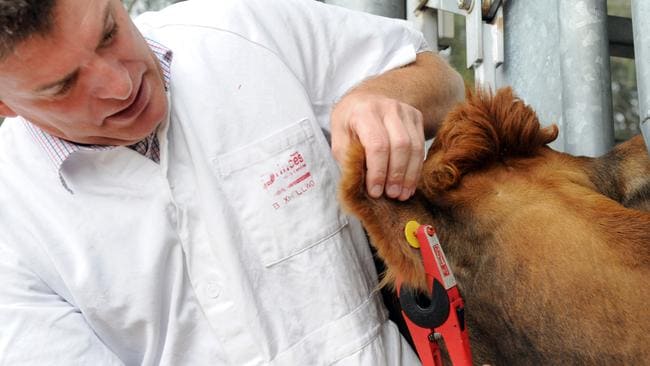
Tagging ist wichtig für Die Tiere, um sie zu identifizieren und zu überwachen. Also, Es ist wichtig, Tags auszuwählen, die den Zweck ohne Komplexität lösen. Es gibt viele Arten von Tags auf dem Markt. You should research and analyze what kind of tags will best suit your requirement and budget and then make the purchase.
What is an ear cattle tag?
An ear cattle tag is a plastic or metal object that carries an identification number on it and is placed in the ears of an animal. Das neue elektronische Identifikations-Tag (EID) verwendet Radio Frequency Identification Device (RFID) Technologie für eine effizientere Tierhaltung. Diese elektronischen Tags verwenden die EID-Nummer oder die Verwaltungsnummer auf der Taste, die auf der Rückseite des Ohrs des Tieres platziert wird.. Die Informationen auf dem Tag werden mit Hilfe von Funkwellen gelesen und gespeichert.
Why do farmers use ear cattle tags?
Landwirten und Viehzüchtern fällt es schwer, die Tätigkeiten ihrer lebenden Bestände zu lokalisieren und zu überwachen, da der Prozess zeitaufwändig und kostspielig ist.. Daher, sie legen Tags auf ihre Tiere, um ihnen zu helfen, die Bestände leicht zu identifizieren und zu überwachen. Die Tags verfolgen auch die Leistung ihrer Rinder und überwachen deren Gesundheit. Diese Aufzeichnungen sorgen für eine ordnungsgemäße Fütterung, Impfung und Verbringung von Tieren im Betrieb. Und, helfen Sie den Landwirten auch, rechtzeitige und korrekte Entscheidungen über den Verkauf der Rinder zu treffen, wenn sie im Betrieb nicht mehr benötigt werden.
You can distinguish between a good and bad ear cattle tag based on following features.

1. Größe – The ear cattle tag is placed on the animal’s ear. Also, it should be big enough to be visible even from a distance and not too big to cause discomfort to the animal. You should be able to write the identification numbers properly on the tag in a way that they are clear and readable. Numbers and bar code should be covering full size of the female tag, leaving 2 mm margin on all sides.
2. Easy to apply – A good tag is easy to apply and is not very complex to use and maintain.
3. Material used for the tag – Metal tags are associated with more damage to the ears than the polyurethane (PU) Tags. There are higher incidences of bleeding and infection at the tagging point when a metal tag is used. A good tag should be made of Ether grade Thermoplastic Polyurethane Elastomer material that should be resistant to ultraviolet light, high and low temperature, and should be tamperproof.
4. Tear resistance – A good tag should not fall out or become unreadable when covered in dirt or mud. The electronic tags are tear resistant and remain attached to the animal for their life time.
5. Male and Female part – A good tag should have the male and female part. The male part is the visual part which is ideally around 27 mm in diameter and has a metal point. The female part is the button with a close head.
6. Printing on tag – A good tag comes with a dark number printing, readable enough from a distance. The print should be such that it doesn’t dissolve over the lifetime of the tag.
7. ISO certified – A good tag must be ISO11784/11785 certified with proper documentation of its manufacturing and application.
RFIDHY provides ISO certified ear cattle tags conforming the industry standards. The tags come in different frequencies from 134.2KHz, 125KHz bis auf bis zu 860 MHz und 960MHz. Diese wasserdichten und stoßfesten RFID-Tags sind so konzipiert, dass die Technologie effizient und problemlos implementiert wird.. Mit einem 100% Leistungsgarantie, RFIDHY’s ear cattle tags last for the lifetime of the animal. The electrical parts of the RFIDHY Ear cattle tags are covered by TPU material which is convenient and strong in the harsh environment too. RFIDY bietet Ihnen den Vorteil, die ID-Nummern nach Ihren Anforderungen zu wählen. Sie können auch Ihre Farbe und den Inhalt auswählen, den Sie auf den Tags drucken möchten.. Diese ISO-11784/11785 zertifizierten Tags sind mit einer dreijährigen Garantie. Diese Tags werden für die Tierhaltung empfohlen., Vieh-Tracking, Haustier und Lab-Identifikation, Tierzucht, Pflanze, und Lebensmittelsicherheitsmanagement.
How is an ear cattle tag applied to the animal?

An ear cattle tag carries the fifteen-digit unique Animal Identification Number (Ain) zusammen mit wenigen anderen Details wie Property Identification Number. Die AIN besteht aus einem 3-stelligen Firmencode und einer 12-stelligen Einzeltiernummer. It can be applied by hand or by an ear cattle tag applicator. Ein Tier kann auf einem Ohr oder beidem, abhängig vom Zweck der Kennzeichnung. Der Knopf wie RFID-Chip wird am Ohr in einem Prozess ähnlich dem Piercing des menschlichen Ohres befestigt. Ein ID-Reader wird verwendet, um die Daten dieser Tags zu scannen und zu sammeln., die dann heruntergeladen und auf einem Computer gespeichert wird. Dieser Prozess verringert die Fehlerwahrscheinlichkeit und führt eine Aufzeichnung aller Daten, die sich auf ein Tier beziehen, an einem anderen.






